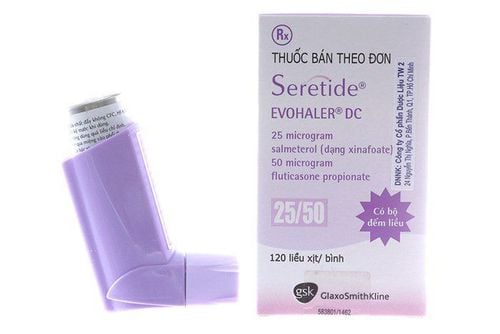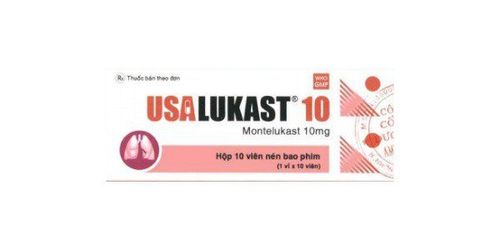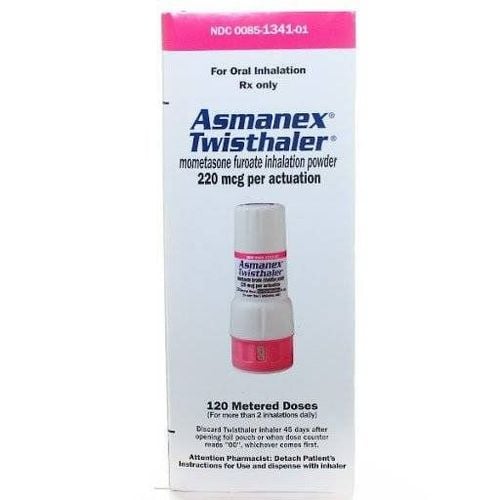This is an automatically translated article.
Symbicort rapihaler is a medicine for control and prevention in asthma and chronic obstructive pulmonary disease. To ensure effective use and avoid side effects, patients need to take the drug exactly as directed by the doctor, professional pharmacist.1. What is Symbicort rapihaler?
What is Symbicort rapihaler? Symbicort rapihaler contains formoterol and budesonide, which have different modes of action but have an additive effect in reducing asthma (asthma) exacerbations.
Ingredients Budesonide: Budesonide is an inhaled glucocorticosteroid that has anti-inflammatory effects, reduces symptoms and reduces the frequency of asthma exacerbations. Inhaled budesonide has fewer severe side effects than systemic corticosteroids. Formoterol ingredients: Formoterol is a selective beta-2 agonist that, when inhaled, causes rapid and prolonged bronchial smooth muscle relaxation in patients with reversible airway obstruction. The bronchodilator effect is dose dependent with onset within 1 to 3 minutes. Symbicort rapihaler is rapidly absorbed and maximum plasma concentrations are reached within 10 minutes after inhalation.
Most of the drug is metabolized by the liver and then excreted by the kidneys. After inhalation, 8 - 13% of the released dose of Symbicort rapihaler is excreted unchanged in the urine.
2. Indications of Symbicort rapihaler
Symbicort rapihaler is indicated in the following cases:
Asthma : Symbicort rapihaler is for the prophylaxis of asthma (asthma), a combination of inhaled corticosteroids and beta-2 agonists. Support for patients not well controlled with inhaled corticosteroids and short-acting inhaled beta-2 agonists. The patient was well controlled with inhaled corticosteroids and beta-2 agonists (long-acting drugs). Chronic Obstructive Pulmonary Disease (COPD): Chronic obstructive pulmonary disease with severe symptoms. Patients with a history of many exacerbations, shortness of breath, and fatigue. Despite routine treatment with long-acting bronchodilators.
3. Contraindications of Symbicort rapihaler
Do not use Symbicort rapihaler in the following cases:
The patient is allergic to budesonide, formoterol or any of the ingredients in the drug.
4. Notes when using Symbicort rapihaler
During the use of Symbicort rapihaler, patients should pay attention to the following issues:
Patients should reduce the dose of the drug slowly, should not stop suddenly after long-term treatment. Patients may experience sudden or continuous worsening of asthma or COPD control. Therefore, patients need to use it cautiously under the direction of a doctor. Patients need to use Symbicort rapihaler at the right dose, regularly. It should not be used as first-line therapy for a severe asthma exacerbation. The drug can cause paradoxical bronchospasm with wheezing that increases suddenly after inhalation. (It is recommended to stop immediately and notify medical personnel.) Caution should be exercised when initiating treatment with Symbicort rapihaler, it should not be used to initiate steroid therapy. Do not use the drug if adrenal insufficiency is suspected. Systemic effects of corticosteroids may occur with inhaled Symbicort rapihaler. Steroid dependence may occur if inhaled Symbicort rapihaler is used regularly. Symbicort Rapihaler is only used during the first trimester of pregnancy and shortly before delivery. However, careful consideration should be given when deciding to use the drug. Symbicort Rapihaler is excreted in human milk. However, because of the relatively low inhalation dose, the amount excreted in breast milk is negligible, and use during lactation may be considered if necessary.
5. Dosage and usage of Symbicort Rapihaler
How to use
Need to shake the spray bottle well before use. Spray 2 times first into the air (if the bottle is new or has not been used for a long time) before spraying into the nose. Put the mouthpiece in the mouth, close the mouthpiece. While pressing the inhaler, inhale slowly and deeply, holding your breath for about 10 seconds. The patient rests for about 30 seconds, then shakes the inhaler again and sprays a second time in the same way. Rinse mouth with water after using the maintenance dose to minimize the risk of oropharyngeal fungal infections. Clean the mouthpiece of the sprayer regularly with a clean, dry cloth. Do not place the sprayer in water. It should be noted: Use a spacer for patients who have difficulty in combining inhalation with spray, children or the elderly to bring better treatment effect by:
Prepare the spacer. After each puff, the drug is released into the inhalation chamber. Have the child take the mouthpiece of the bottle completely, instructing the child to breathe 5 to 10 times through the mouthpiece. For young children who cannot breathe through the mouthpiece, a mask should be used. Prepare the appropriate mask size for each age group. Dosage in patients with asthma (asthma)
Adults and children over 12 years: 2 sprays x 2 times/day. The maximum maintenance dose is 4 sprays/day. Elderly patients do not require dose adjustment. Not recommended for use in patients younger than 12 years of age. Dosage in patients with asthma (asthma)
Adults: 2 sprays/time x 2 times/day.
6. Drug interactions
Some interactions of Symbicort Rapihaler with other drug classes may be encountered as follows:
Beta blockers may partially or completely block the effect of the drug Other sympathomimetic drugs such as: stimulants β-adrenergic or sympathomimetic amine (ephedrine) co-administered with Symbicort Rapihaler will have an additive effect. Xanthine derivatives, mineral corticosteroids and diuretics: will cause hypokalemia if taken together. Monoamine oxide inhibitors, tricyclic antidepressants, quinidine, disopyramide, procainamide, phenothiazines and antihistamines when combined with Symbicort Rapihaler will increase the risk of cardiac arrhythmias, hypertension. Patients under anesthesia with halogenated hydrocarbons are at increased risk of cardiac arrhythmias if they are receiving Symbicort Rapihaler. Concomitant administration of Symbicort Rapihaler with other beta-agonists or anticholinergics will potentiate the bronchodilator effect.
7. Symbicort Rapihaler side effects
During the use of Symbicort Rapihaler, patients may experience side effects with the following frequency:
Common
Palpitations. Candida infection in the oropharynx. Pneumonia in a patient being treated for chronic obstructive pulmonary disease, causing mild throat irritation, cough, hoarseness. Headache, shivering. Uncommon
Tachycardia . Feeling of nausea, diarrhea. Slight weight gain. Cramps (cramps). Excited, restless, hot. Blurred vision. Rare
Anaphylactic reactions, angioedema, urticaria. Atrial fibrillation, extrasystoles, angina pectoris Adrenal suppression, decreased bone mineral density. Bronchospasm. Hypokalemia, hyperglycemia Body weakness. Glaucoma, cataracts. In summary, Symbicort Rapihaler is used to prevent, control, reduce the frequency of asthma attacks or reduce exacerbations of chronic obstructive pulmonary disease. Patients need to use the drug regularly, at the right dose to achieve the best treatment effect.
Follow Vinmec International General Hospital website to get more health, nutrition and beauty information to protect the health of yourself and your loved ones in your family.
Please dial HOTLINE for more information or register for an appointment HERE. Download MyVinmec app to make appointments faster and to manage your bookings easily.













